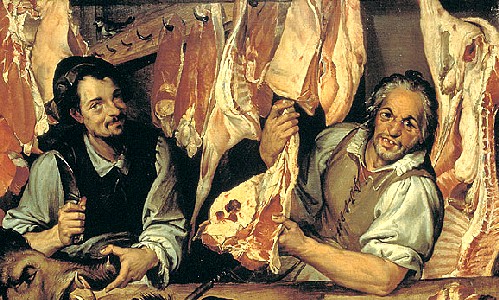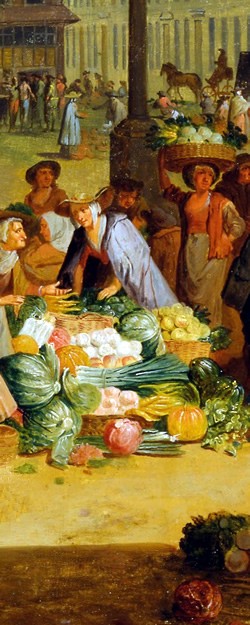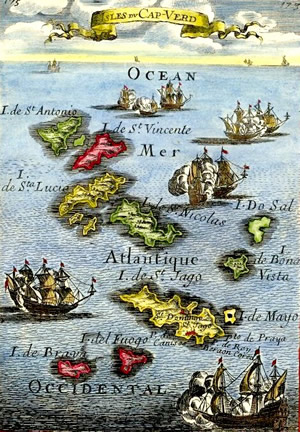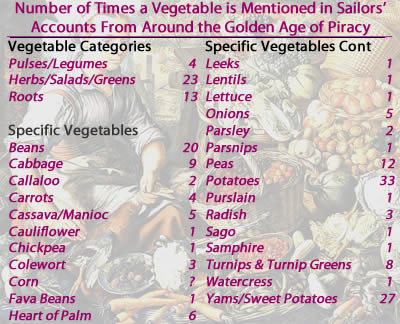
Vegetables in Sailor's Accounts Menu: 1 2 3 4 Next>>
Vegetables in Sailors Accounts During the Golden Age of Piracy, Page 1
Like fruit, fresh vegetables were not available when a ship was at sea on a long voyage, except within the first week or two after leaving land. Dried peas were the one vegetable commonly found during a long voyage because they could be preserved. This was a standard food provided by the navy, typically either combined with flour to make a savory pudding or with pork. As a result, most instances of vegetables are found in sailors book when they were on land.
There

Artist: Bartolomeo Passarotti
Now Who Would Expect This to Be the First Image in a Vegetable Article? The Butchers Shop (1580)
is a perception that the English did not eat a lot of vegetables during this period. Historian Laura Giannetti traces this back to Aristotle's four elements of earth, water, air and fire, which was arranged in a hierarchical order from the basest to the most spiritual. This, she explains is reflected in society and nutrition. "Thus, people at the base of society were to eat the most basic, earthbound foods, such as vegetables, greens, legumes, and herbs, while the most noble should primarily eat foods with no evident links to the soil such as meat... [resulting in] the association of vegetables with the peasant diet or with the “lowest” form of nutrition"1. While Mediterranean societies had all but rejected this concept by the seventeenth century, "cultural stigma attached to foods like vegetables and especially raw greens such as salad remained quite vivid in northern Europe; in fact, a number of Italian writers of the period report the ‘foreign’ opinion that raw greens are a food fit for animals, not for humans."2
There is certainly some support for her view. Writing in 1718, Physician Clifton Wintringham explained,

Artist: Pieter Angillis
Selling Vegetables, Covent Garden (c. 1715)
The Substances taken from the Animal Kingdom, are undoubtedly best qualified to repair the Losses our Bodies daily sustain, both in their Solids and Fluids… Now the Parts taken from the Body of an Animal, being such as have been already applied to this Purpose, and consisting of the very Matter by which it was nourish'd, must necessarily be better suited to this End, than such us are taken from the Vegetable kingdom, these being already prepar'd for that Purpose by the Action of the Stomach, Lungs, &c. of the Animal we feed on, and selected from a vast Quantity of Matter less suited to this End; as appears by the great Quantity of Vegetable Food such Animals require, as are sustain'd by it, in Proportion to the Increase of Bulk from it, as well as Quantity of Excrements voided by all such Creatures. So that were we sustain'd by Vegetable Food, all this must be done by the Action of our own Bowels and Juices, and consequently the Animal, must be much more nourishing, than the Vegetable Food.3
His rather convoluted justification for eating meat instead of vegetables smacks of prejudice against 'base' foods such as vegetables. The English preference for flesh was noted by French traveller César De Saussure, who wrote in 1727, "English people are large eaters; they prefer meat to bread, some people scarcely touching the latter. ...Noblemen who have travelled generally have cooks from France, and eat partly in the foreign fashion, partly in the English, adding pastries and French garnishings to the roast meats and English puddings."4
While this may have been the prevailing view, it was certainly not the only one. Some English authors presented an opposing view, most notably merchant Thomas Tryon, a proponent of a more vegetarian diet. In his 1697 book The way to health and long life, he says
one might eat plentifully of this [the turnip] with a great deal of safety; but of Flesh sparingly, as most Nations do (England excepted;) In France, Spain and Portugal and other Countries, a pound of Flesh, with Herbs and Roots will make a Dinner for four or five People: But an English man will eat at one Meal a Pound or two of fat Flesh, and scarcely a bit of Bread with it, there are but too many in this Nation that follow 'this dangerous and noxious custom.5
Tryon was more of an outlier as his comment suggests. Yet there was an appreciation for vegetables by some authors, particularly when considering the ongoing problem of scurvy faced by long distance sailors. Many authors recognized food as method for curing scurvy point first to citrus fruits. However, in his notes, Samuel Pepys said a sailor's diet, "which should support them, do by reason of its saltness give them diseases not cured till put on shore, and there refreshed with fruits
and herbs and roots."6 Herbs and roots both refer to vegetables. Navy surgeon John Moyle wrote that, among other things, scurvy resulted "from [an] over full dyet, of
Flesh or Fish,

Artist: Alain Manesson Mallet - Cape Verde Islands, (1683)
and especially when there wants the succulency of fresh Vegetables, as on shoar, for in those Countrys where they drink Wine, and eat green Fruit, as Lemons, Apples, or Roots and Herbs, as Salads, together with their Meat, such are seldom or never troubled with the
Scurvy"7. Several vegetables were indeed rich sources of vitamin C and the botanists and physicians of the period were sometimes quite accurate in recognizing that certain vegetables cured scurvy, even if they didn't fully understand why.
Fresh vegetables were usually purchased by ships when they made landfall around this period. Historian Peter Earle notes that when the Viner Frigott was in the Mediterranean from 1676-8 and the Upton Galley touched at Bengal in 1701, both "bought vegetables and fruit and consumption of these by sailors was probably higher than usually imagined with beneficial effects on the scurvy rate."8 He elsewhere states,
Fresh vegetables, such as 'greens', onions, carrots and potatoes, were regularly bought by ships setting out across the Atlantic, often at the last moment... Ships in the West Indies or America bought yams, sweet potatoes, squashes, citrus fruits and other local products for the voyage home, while East Indiamen also took every opportunity to freshen up their men's diet in places such as the Cape Verde Islands.9
So there is evidence that vegetables were purchased for shipboard consumption, although it is far less than the evidence for consumption of fruits, meats and fish. In fact many of the sailors' accounts that do discuss procuring vegetables when stopping don't even bother to indicate which vegetables they purchased. They instead generically refer to them using period terms such as herbs, salads, greens, 'legumen' and roots. With this in mind, let's look at the vegetables mentioned in the period accounts in detail.
1 Laura Giannetti, "Italian Renaissance Food-Fashioning or The Triumph of Greens", California Italian Studies, gathered from escholership.org, 9/16/22, p. 2; 2 Giannetti, p. 4; 3 Clifton Wintringham, A Treatise of Endemic Diseases, 1718, p. 113-4; "LETTER VIII, Islington Near London, May 29, 1727", 4 César De Saussure, A Foreign View of England In The Reigns Of George I and George II, Madame Van Muyden, ed., 1902, p. 220; 5 Thomas Tryon, The way to health and long life, 1697, p. 144-5; 6 Samuel Pepys, “NOTES GENERAL OF THE NAVY ETC., PORTSMOUTH, August 1, 1683”, The Tangier Papers of Samuel Pepys, Vol. 73, E Chappell, ed., 1935, p. 111; 7 John Moyle, Abstractum chirurgiae marinae, 1686, p. 96; 8 Peter Earle, Sailors: English Merchant Seamen 1650-1775, 1998, p. 89; 9 Earle, p. 86
Vegetable Found In Sailors Accounts
The number of specifically named vegetables found in the period sailor's accounts is 26, about half the number of specific vegetables mentioned. However, this leaves out 40 instances which mention broader categories of vegetables by sailors, including herbs/salads/greens, legumes/pulses and roots. In addition, examples of period ships

Image Artist: Frans Snyders - Fruit and Vegetable Stall (17th c)
stopping at a shore location to obtain 'fresh provisions' include 65 instances, many of which come from pirate accounts.1 So there may be quite a bit more in the accounts than the specific vegetable mentions suggest. Still, without more information, 'fresh provisions' is vague; it could refer to vegetables, fruit or even non-salt meats. (The largest number of descriptions which provide detail on the meaning of 'fresh provisions' refer to non-salt meats.2) In the end, the number of specific mentions of vegetables being procured for a ship suggest that they were not considered as important as meat or grains nor as interesting as foreign fruits to the common sailor.
The number of vegetables mentioned doesn't tell the whole tale, however. Thirty-two different sailors' accounts mention encountering vegetables during their voyage, which is three more than the mentioned fruit. While not tremendously more, it does suggest slightly wider support for obtaining vegetables during sea voyages.
Unlike fruits, the vegetables discussed in the sailor's accounts from this period nearly all talk about them as if they were the same as the vegetables which were available in England, despite the fact that some must have been specific to foreign climates. Also unlike fruits, almost no effort is made to describe the vegetables found in foreign countries, even by normally descriptive authors like William Dampier. Combined with the fact that many descriptions unceremoniously lump vegetables into broad categories as noted, it appears that the sailors either weren't very concerned about vegetables as food or didn't regard them as significant enough to discuss in detail.
Each entry for individual vegetables mentioned in a sailor account first gives a common name of the vegetable followed by the genus and species in parenthesis where it is known.

Image Artist: Joachim Beuckelaer - Market Woman with Fruit, Vegetables &c. (1564)
In some cases there are several species which may be applicable so only the genus is provided. The entry then indicates any names(s) given to the vegetable in the sailor's accounts, the number of times that vegetable appears in the various sailor accounts under study, the number of different accounts in which it appears and the number of different ship's journeys in which it appears (some authors accounts present journeys on a several ships, so there can be overlap.) A chart is also included showing which types of sailors mention the vegetable.
The main body of the text includes a period description of the vegetable, providing the details of the taste and preparation of the vegetable found in books from that time. For most vegetables, most sailor's books simply mention the name of the vegetable found without going into any detail about flavor or preparation. In those cases, information is taken from other sources. The emphasis in this article is on the period descriptions and understanding of vegetables. In the rare instances where period descriptions are lacking or incomplete, modern descriptions are used.

Artist: Albert Anker
Hippocrates Composite Portrait

Paracelsus Aureolus Theophrastus Bombastus
von Hohenheim (1455)
Since this website concerns medicine, some information on humoral properties originally suggested in the works of Hippocrates. He identified four humoral properties present in nearly everything including foods. This was expanded upon by some of his later followers, particularly Galen of Pergamon The four properties associated with food include hot, cold, moist and dry. According to the primary medical theory in use during this period, the humoral properties of food combined with a patient's own humoral makeup (affecting the body's humoral fluids blood, phlegm, yellow and black bile) impacting the patient's health.
One botanical author regularly used in this article - Louis Lémery - relies upon the three Paracelsian principles instead of humors. These principles include salt, which composes the solid state of a body; sulfur, responsible for an inflammable or fatty state; and mercury, engendering a smoky (vaporous) or fluid state.3 The translation of Lémery's work uses the terms salt, oil and phlegm, with phlegm apparently corresponding to mercury.
Finally, specific comments of interest about the medicinal or healing properties of a vegetable are given. While these sometimes tie directly into the humoral theory (more often, indirectly), surgeons would typically have been a little less interested into these theoretical connections than physicians, preferring to see how a vegetable would help or hinder a particular disease or aspect of a patient's health.
For ease of reference, all the vegetables included in this section can be directly accessed in the list below. Clicking on the vegetable will take you directly to the information for it.
| Vegetable Categories Mentioned in Sailors' Accounts During the Golden Age of Piracy | ||||
|---|---|---|---|---|
| Legumes | Salading | Roots |
Specific Vegetables Found in Sailors' Accounts During the Golden Age of Piracy |
|
| Beans | Cabbage | Callaloo | Cassava/Manioc | Carrot |
| Cauliflower | Chickpea | Colewort | Corn | Fava Bean |
| Heart of Palm | Leeks | Lentils | Lettuce | Onions |
| Parsley | Parsnips | Peas | Potatoes | Purslane |
| Radish | Sago | Samphire | Turnips & Greens | Watercress |
| Yams/Sweet Potatoes |
1 John Atkins, A Voyage to Guinea and Brazil, 1735, p. 260; Edward Barlow, Barlow’s Journal of his Life at Sea in King’s Ships, East and West Indiamen & Other Merchantman From 1659 to 1703, p. 69, 155, 180, 208, 216, 273, 325, 340, 353, 355, 364, 366, 402, 431, 444, 463, 488, 496, 498, 505, 509, 512 & 534; Edward Cooke, Voyage to the South Seas, 1712, p. 64; John Covel, "Extracts from the Diaries of Dr. John Covel, 1670-1679," Early Voyages and Travels in the Levant, edited by J. Theodore Bent, 1893, p. 117 & 155; Pirates in Their Own Words, Ed Fox, ed., 2014, p. 23, 280, 282 & 284; Pirates in Their Own Words II, Ed Fox, ed., 2022, p. 77, 91, 92, 289 & 306; Amedee-Francois Frezier, Voyage to the South Seas, 1717, p. 135; Daniel Defoe [Captain Charles Johnson], A General History of the Pyrates, Shonhorn, ed., 1999, p. 125, 127, 129, 179, 218, 230, 323, 479, 522, 525, 620, 627; Stephen Martin-Leake, The Life of Sir John Leake, 1920, p. 222; John Ovington, A Voyage to Suratt in the Year 1689, 1696, p. 41, 482 & 505; Thomas Phillips, 'A Journal of a Voyage Made in the Hannibal', A Collection of Voyages and Travels, Vol. VI, Awnsham Churchill. ed., p. 210; Basil Ringrose, The Adventures of Capt. Barth. Sharp, And Others, in the South Sea, 1684, p. 71; Jeremy Roch, Three Sea Journals of Stuart Times, Bruce S. Ingram, ed., 1936, p. 128; Francis Rogers, Three Sea Journals of Stuart Times, Bruce S. Ingram, ed., 1936, p. 148 & 199; George Shelvocke, A Voyage Round the World by Way of the Great South Sea, 1726, p. 13, 23 & 51; Henry Teonge, The Diary of Henry Teonge, Chaplain on Board H.M.’s Ships Assistance, Bristol, and Royal Oak, 1675-1679, 1825, p. 24 & 144; Nathaniel Uring, A history of the voyages and travels of Capt. Nathaniel Uring, 1928, p. 2, 90 & 185; 2 See for example, Edward Barlow, Barlow’s Journal of his Life at Sea in King’s Ships, East and West Indiamen & Other Merchantman From 1659 to 1703, p. 180, 505 & 521; William Dampier, A Continuation of a New Voyage Round the World, Vol III, 1709, p. 48; Pirates in Their Own Words, Ed Fox, ed., 2014, p. 297; Charles Grey, Pirates of the Eastern Seas, 1618-1723, 1971, p. 30; Daniel Defoe [Captain Charles Johnson], A General History of the Pyrates, Shonhorn, ed., 1999, p. 620; Thomas Phillips, "A Journal of a Voyage Made in the Hannibal", A Collection of Voyages and Travels, Vol VI, Awnsham Churchill ed, 1732, p. 210; Nathaniel Uring, A history of the voyages and travels of Capt. Nathaniel Uring, 1928, p. 167; 3 "From Alchemy to Chemistry: Five Hundred Years of Rare and Interesting Books", illinois.edu website, gathered 7/28/22;

